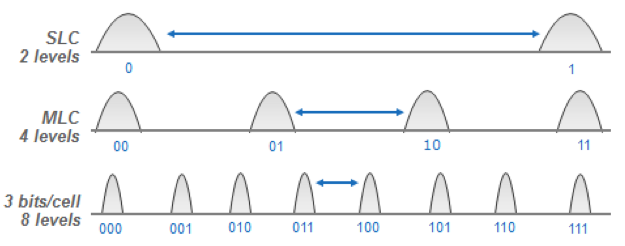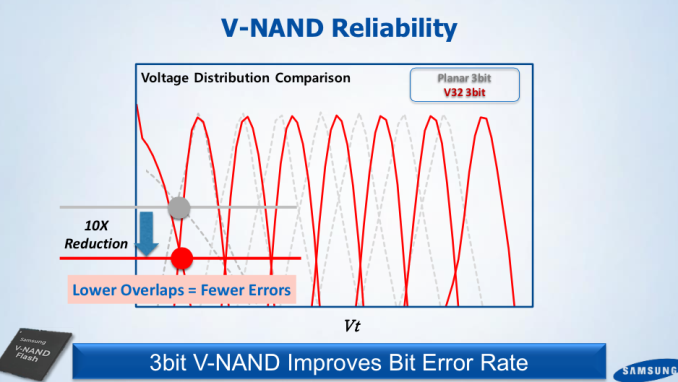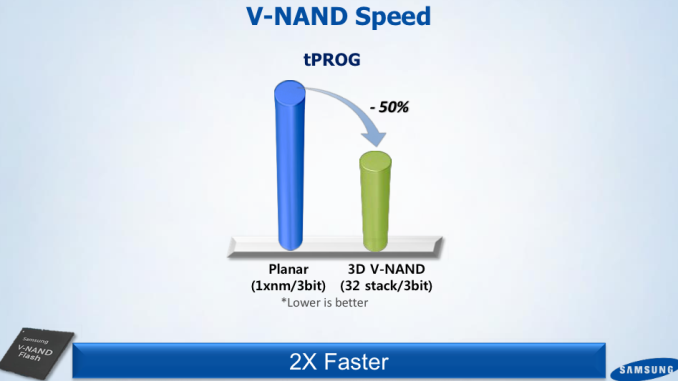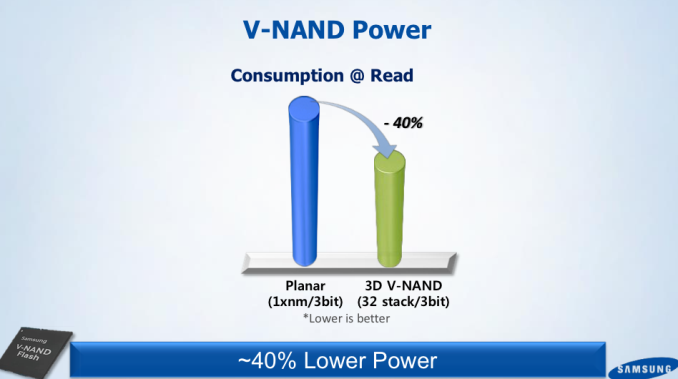Samsung SSD 850 EVO (120GB, 250GB, 500GB & 1TB) Review
by Kristian Vättö on December 8, 2014 10:00 AM ESTThree Bits and Three Dimensions: What's the Deal?
I've covered 3D NAND and TLC NAND in detail in the past and in this article I'll just explain what 3D technology means to TLC NAND and vice versa, so head over to the links above if you are in the search for a deeper analysis of the two technologies.
Truth to be told, 3D technology is ideal for TLC. The fundamental problem of TLC NAND has always been the limited endurance and performance, which is caused by the additional voltage states that are needed to store three bits (i.e. eight possible bit outputs) in one cell. With eight voltage states compared to four in MLC, TLC NAND is less resistant to wear out because it takes a smaller change in the cell charge to corrupt the cell value. Due to the way NAND works, the cells (or the insulators in the cell to be exact) wear out over time, which induces electron leakage that alters the cell charge and hence the voltage state. This gets worse with die shrinks because the number of electrons decreases, making the NAND even less tolerant to wear out.
The key aspect of 3D V-NAND is the process node. By going back to 40nm lithography, the number of electrons increase exponentially, which makes TLC a much more viable technology than it was with modern planar NAND. Obviously, V-NAND doesn't change the basics of TLC NAND because it still takes eight voltage states to differentiate all the possible 3-bit outputs, but thanks to the increased number of electrons there is more breathing room between the states and thus the cells are more error tolerant.
Samsung claims 10x reduction in voltage state overlaps, which is a massive change for the better. You can see how crammed the planar TLC voltage states are, so it's no wonder that the endurance is low because the states are practically overlapping at each point in the voltage distribution and hence even tiny changes in the cell voltage can alter the cell's voltage state.
The larger cell structure also enables higher performance because it takes less iterations to program a cell. With planar TLC NAND it took multiple very high voltage pulses as well as numerous verification process to reach the right charge, but with looser voltage distribution the programming process has less steps and thus takes less time.
And given the lower read/program latencies and less need for error correction, the power consumption is also considerably lower.
In addition to better latency and power consumption characteristics, Samsung claims doubled the density over its 19nm planar TLC NAND, but without knowing the die size of 128Gbit 32-layer TLC V-NAND, it's hard to say how accurate this is. There have been some whispering that the 128Gbit die would actually be identical to the 86Gbit MLC die because 86Gbit multiplied by 1.5 equals 129Gbit and at the silicon level MLC and TLC aren't any different, but for now that's just speculation.
What I do know is that Samsung started the mass production of TLC V-NAND later, which suggests that the two aren't completely uniform. Moreover, from what I know TLC NAND requires some changes to the peripheral circuitry in order to read three bits from one cell, so while the NAND memory arrays could be alike the die size is still likely at least slightly different. Anyway, we'll find out when Chipworks (or some other silicon analysis company) takes a closer look at the NAND die itself.















97 Comments
View All Comments
KAlmquist - Monday, December 8, 2014 - link
My guess is that Samsung doesn't have the ability to produce very much V-NAND. So the 850 PRO, and now the 850 EVO, are priced to encourage most people to choose SSD's from the 840 line rather than the 850 line, preventing demand for the 850 line from exceeding the supply.rms141 - Monday, December 8, 2014 - link
The absence of the Samsung 840 Pro from the Storage Bench 2013 section is pretty odd. Why wouldn't you include the previous generation's higher performing product? This is a little bit like publishing a GTX 970 review without including the GTX 780 for reference.Kristian Vättö - Tuesday, December 9, 2014 - link
You can always use the Bench tool to compare any and all drives that we have tested over the years:http://www.anandtech.com/bench/SSD/65
fokka - Monday, December 8, 2014 - link
it doesn't make much sense to complain about the msrp when the drive is just now trickling to retailers. you're probably not gonna make a good deal on a 850 evo before christmas, but the prices will come down considerably in q1/q2 2015, they always do.that said, i wouldn't mind paying a couple bucks more for a 850, compared to a 840, since it's just the all around better drive and it's lower power consumption alone makes it the better option for laptops.
pitted against an mx100 it might be a tougher sell, but let's just wait a bit for the prices to come down and give the early adopters some time to beta-test the firmware for us in the meantime.
Morawka - Tuesday, December 9, 2014 - link
Does TurboWrite, native encryption, and TRIM work in RAID 0 on the 850 EVO? Thats the only way i would invest $500+ into a SSD still bottlenecked by Sata 6hojnikb - Tuesday, December 9, 2014 - link
All of that should work with appropriate motherboard/storage drives, because drive itself is not aware whenever is in RAID or not.hojnikb - Tuesday, December 9, 2014 - link
*driverspaesan - Tuesday, December 9, 2014 - link
I just got a 1TB 840 evo for $369. No way the 850 evo is worth the extra $100.R3MF - Tuesday, December 9, 2014 - link
How do you conduct this review of a perfomance oriented SSD without discussing:1. m.2 format (or lack thereof)?
2. PCIe 3.0 4x m.2 performance (vs SATA 6G)?
3. NVME m.2 performance (vs SATA 6G)?
It is the end of 2014, who seriously spends £320 on a 1TB performance SSD without considering the high-speed m.2 drives just around the corner, to which a growing number of enthusiasts have empty slots on their shiny new motherboards?
hojnikb - Tuesday, December 9, 2014 - link
>How do you conduct this review of a perfomance oriented SSD without discussing:EVO is not a performance oriented drive. 850PRO is. And this was already discussed in other reviews/seperate articles.